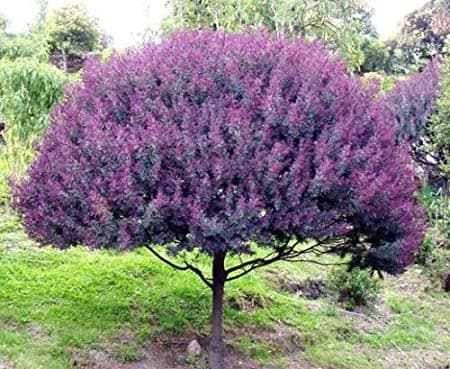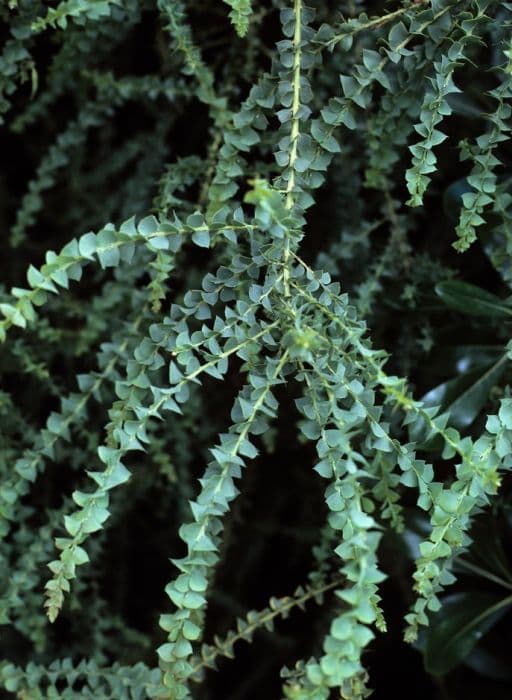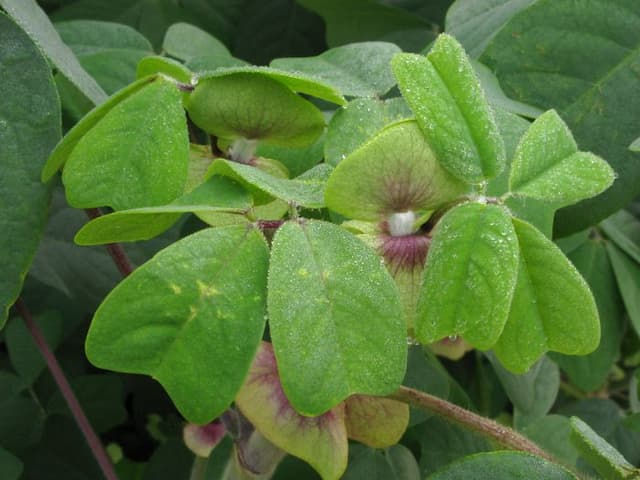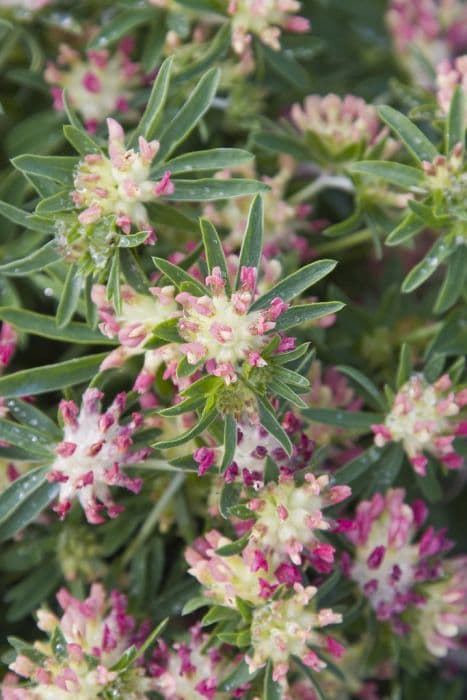Sweet pea Lathyrus odoratus 'Oklahoma'

ABOUT
The sweet pea 'Oklahoma' is notable for its vibrant and colorful flowers, which are usually a rich, deep hue. The petals have a silky texture, and the blossoms are typically arranged in clusters that create a showy display. Its stems are slender and adorned with pairs of leaflets that have a delicate, almost feathery appearance due to tendrils that help the plant climb. The overall shape of the plant is graceful, with a slightly rambling habit that lends itself well to being supported by trellises or other structures. The flowers exude a delightful fragrance that is sweet and reminiscent of honey and orange blossoms, contributing to its popularity in gardens.
About this plant
 Names
NamesFamily
Fabaceae.
Synonyms
Sweet Pea, Everlasting Pea, Garden Pea, Oklahoma Sweet Pea.
Common names
Lathyrus odoratus.
 Toxicity
ToxicityTo humans
Sweet pea is a plant that is considered mildly toxic to humans if ingested in large quantities. It contains a compound called Lathyrism that can lead to a condition known as lathyrism if consumed in large amounts. Symptoms can include muscle weakness and paralysis, labored breathing, convulsions, and may be potentially fatal in severe cases. The seeds are the most toxic part of the plant, and it is particularly important to ensure that children do not ingest them.
To pets
Sweet pea is also toxic to pets, such as dogs and cats, and can cause similar symptoms to those observed in humans. Ingesting the seeds or plant material might result in vomiting, diarrhea, lethargy, tremors, seizures, and more severe neurological symptoms. Again, it is the seeds that contain the highest levels of the toxic compounds, and they should be kept out of reach of pets to prevent accidental ingestion.
 Characteristics
CharacteristicsLife cycle
Annuals
Foliage type
Deciduous
Color of leaves
Green
Flower color
Varies
Height
6 feet (1.8 meters)
Spread
1 foot (0.3 meters)
Plant type
Climber
Hardiness zones
2
Native area
Mediterranean
Benefits
 General Benefits
General Benefits- Aesthetic Appeal: Adds vibrant color and beauty to gardens with its range of pink, white, and purple flowers.
- Fragrance: Emits a delightful sweet scent that can enhance the sensory experience of a garden or indoor space.
- Attracts Pollinators: Draws bees, butterflies, and other beneficial insects, supporting pollination.
- Screening: Can be used to create natural, living screens for privacy or to hide unsightly areas.
- Cut Flowers: Makes excellent cut flowers for bouquets and floral arrangements due to their long stems and attractive blooms.
- Vertical Interest: Climbing habit adds dimension and vertical interest to the garden, ideal for trellises and fences.
- Edible Harvest: Young pods and seeds can be harvested for culinary uses, although care must be taken to avoid toxicity with excessive consumption.
- Seasonal Interest: Blooms mainly in spring and summer, providing seasonal interest and variety throughout these periods.
 Medical Properties
Medical PropertiesThis plant is not used for medical purposes.
 Air-purifying Qualities
Air-purifying QualitiesThis plant is not specifically known for air purifying qualities.
 Other Uses
Other Uses- Lathyrus odoratus 'Oklahoma', commonly known as Sweet pea, can be used as a source of inspiration for artists and photographers due to its vibrant colors and aesthetic appeal.
- Its dried petals can be incorporated into homemade potpourri mixes to provide a natural, delicate fragrance to living spaces.
- Sweet peas can serve as a teaching tool in educational settings, demonstrating plant growth and the basics of horticulture to students of all ages.
- They are often used as a natural dye source for fabrics, yielding subtle hues when the flowers are processed properly.
- The plant can be employed in companion planting, helping to support and enhance the growth of certain vegetables like tomatoes by repelling pests.
- Its tendrils can be used as organic material in crafting, such as making natural wreaths or decorative elements in flower arrangements.
- Beekeepers may plant Sweet peas around apiaries as they attract pollinators, which can benefit the health and productivity of bee colonies.
- Due to its pleasing scent, its flowers can be placed in small satchels to create natural air fresheners for cars or closets.
- Sweet peas can be used in the practice of aromatherapy, where the scent is believed to contribute to relaxation and stress reduction.
- The vines of the Sweet pea can provide a natural privacy screen or green wall when grown along fences or trellises in personal and community gardens.
Interesting Facts
 Feng Shui
Feng ShuiThe Sweet Pea is not used in Feng Shui practice.
 Zodiac Sign Compitability
Zodiac Sign CompitabilityThe Sweet Pea is not used in astrology practice.
 Plant Symbolism
Plant Symbolism- Delicate Pleasures: Often referred to as Sweet Pea, Lathyrus odoratus 'Oklahoma' is emblematic of the simple, fleeting joys in life, a reminder to savor the small, pleasant moments.
- Goodbye or Departure: Sweet Pea can symbolize a fond farewell or a good wish for a new beginning as it's often given when someone is leaving or moving on to symbolize a wish of good luck and positive regard.
- Blissful Pleasure: The intoxicating fragrance and lovely blooms of Sweet Pea denote the bliss and pleasure one can find in life, evoking a sense of happiness and contentment.
- Thank You: Giving Sweet Pea flowers is a way to express gratitude, making them the perfect choice to say thank you for a kind act or pleasant experience shared.
- Delicacy: With its tender stems and delicate petals, the Sweet Pea can symbolize the fragility and daintiness of a situation or person, often associated with a gentle touch or tender emotion.
 Water
WaterSweet peas, such as the 'Oklahoma' variety, should be watered deeply once a week, providing about one to one and a half gallons of water per plant or enough to saturate the soil to a depth of about one inch. It's important to avoid overhead watering to prevent mildew and other fungal diseases. Instead, use a soaker hose or water at the base of the plant. During periods of high heat or drought, you may need to increase watering frequency. However, it's crucial to let the soil dry out slightly between waterings to prevent root rot.
 Light
LightSweet peas like 'Oklahoma' thrive in full sun, requiring at least six hours of direct sunlight a day. They perform best when planted in a location that receives morning sunlight and some afternoon shade to protect them during the hottest part of the day. An eastern or southern exposure is ideal for these plants to flourish.
 Temperature
TemperatureSweet peas such as 'Oklahoma' favor cool to moderate temperatures, with the ideal range being between 55 and 65 degrees Fahrenheit. They can tolerate a minimum temperature of around 25 degrees Fahrenheit and a maximum of about 75 degrees Fahrenheit, but prolonged exposure outside this range can be detrimental. Flowering is often best in the cooler part of their range.
 Pruning
PruningPruning sweet peas like 'Oklahoma' is essential for encouraging more blooms and preventing the plant from becoming too leggy. Pinch out the tips of the plant when they are 4-6 inches tall to promote bushier growth. Continue to deadhead spent flowers regularly to encourage new blooms. The best time for major pruning is in late winter or early spring before new growth begins.
 Cleaning
CleaningAs needed
 Soil
SoilFor Sweet Pea 'Oklahoma', the best soil mix is well-draining with rich organic matter; compost or well-rotted manure enhances growth. A soil pH of 6.0 to 7.5 is optimal for these fragrant flowers, ensuring a neutral to slightly alkaline environment. To retain moisture while preventing waterlogging, a mix of two parts garden soil, one part compost or aged manure, and one part perlite or coarse sand is recommended.
 Repotting
RepottingSweet Pea 'Oklahoma' typically does not require frequent repotting as they are annual plants. They are usually sown directly where they are to flower or started in biodegradable pots that can be planted whole into the garden to avoid root disturbance.
 Humidity & Misting
Humidity & MistingSweet Pea 'Oklahoma' prefers moderate humidity levels, but it's adaptable to the ambient outdoor humidity where it's grown as long as it’s not extremely arid or excessively humid. Consistent airflow helps prevent fungal diseases in more humid environments.
 Suitable locations
Suitable locationsIndoor
Grow Sweet Peas indoors with ample light; use deep pots.
Outdoor
Plant in sun, support vines, keep well-watered.
Hardiness zone
2-11 USDA
 Life cycle
Life cycleSweet pea 'Oklahoma' begins its life as a seed, sown in either late winter or early spring, depending on the climate, where it germinates and develops a small root system and shoots. The seedlings grow rapidly in fertile, well-drained soil, developing climbing tendrils and compound leaves as they mature. By late spring or early summer, the plants start producing fragrant, colorful flowers, typically in shades of red, which are attractive to pollinators. After pollination occurs, the flowers develop into seed pods, and by late summer or early fall, these pods mature, containing several seeds which can be harvested for future planting. With the arrival of the first frost, the annual sweet pea 'Oklahoma' will die, having completed its life cycle within a single growing season. If seed pods are left on the plant, they may self-seed and produce new plants in the following growing season, starting the cycle anew.
 Propogation
PropogationPropogation time
Spring to early summer
The most popular method of propagation for the Sweet Pea, Lathyrus odoratus 'Oklahoma', is through seeds. The seeds can be sown directly into the ground in early spring when the soil can be worked and the threat of frost has passed. However, to get a head start, seeds can be sown indoors 6 to 8 weeks before the last expected frost date. For best results, seeds should be nicked with a file or soaked in water for several hours to overnight to soften the hard seed coat, which helps to stimulate germination. When sowing, place the seeds at a depth of about 1 inch (2.54 cm) and space them roughly 2 to 3 inches (5 to 7.6 cm) apart. Seedlings usually emerge within 10 to 21 days, depending on soil temperature and conditions. After the seedlings have developed a set of true leaves and there is no longer a risk of frost, they can be transplanted outdoors to their final growing location, ensuring they have support for climbing as they grow.









